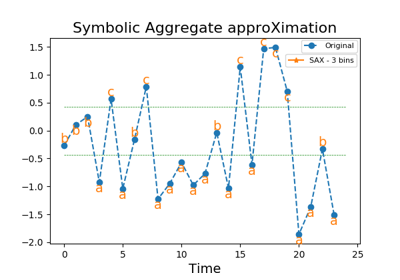pyts.approximation.SymbolicAggregateApproximation¶
-
class
pyts.approximation.SymbolicAggregateApproximation(n_bins=4, strategy='quantile', alphabet=None)[source]¶ Symbolic Aggregate approXimation.
Parameters: - n_bins : int (default = 4)
The number of bins to produce. It must be between 2 and
min(n_timestamps, 26).- strategy : ‘uniform’, ‘quantile’ or ‘normal’ (default = ‘quantile’)
Strategy used to define the widths of the bins:
- ‘uniform’: All bins in each sample have identical widths
- ‘quantile’: All bins in each sample have the same number of points
- ‘normal’: Bin edges are quantiles from a standard normal distribution
- alphabet : None, ‘ordinal’ or array-like, shape = (n_bins,)
Alphabet to use. If None, the first n_bins letters of the Latin alphabet are used. If ‘ordinal’, integers are used.
References
[R2014a3481a12-1] J. Lin, E. Keogh, L. Wei, and S. Lonardi, “Experiencing SAX: a novel symbolic representation of time series”. Data Mining and Knowledge Discovery, 15(2), 107-144 (2007). Examples
>>> from pyts.approximation import SymbolicAggregateApproximation >>> X = [[0, 4, 2, 1, 7, 6, 3, 5], ... [2, 5, 4, 5, 3, 4, 2, 3]] >>> transformer = SymbolicAggregateApproximation() >>> print(transformer.transform(X)) [['a' 'c' 'b' 'a' 'd' 'd' 'b' 'c'] ['a' 'd' 'c' 'd' 'b' 'c' 'a' 'b']]
Methods
__init__(self[, n_bins, strategy, alphabet])Initialize self. fit(self[, X, y])Pass. fit_transform(self, X[, y])Fit to data, then transform it. get_params(self[, deep])Get parameters for this estimator. set_params(self, \*\*params)Set the parameters of this estimator. transform(self, X)Bin the data with the given alphabet. -
__init__(self, n_bins=4, strategy='quantile', alphabet=None)[source]¶ Initialize self. See help(type(self)) for accurate signature.
-
fit_transform(self, X, y=None, **fit_params)¶ Fit to data, then transform it.
Fits transformer to X and y with optional parameters fit_params and returns a transformed version of X.
Parameters: - X : numpy array of shape [n_samples, n_features]
Training set.
- y : numpy array of shape [n_samples]
Target values.
- **fit_params : dict
Additional fit parameters.
Returns: - X_new : numpy array of shape [n_samples, n_features_new]
Transformed array.
-
get_params(self, deep=True)¶ Get parameters for this estimator.
Parameters: - deep : bool, default=True
If True, will return the parameters for this estimator and contained subobjects that are estimators.
Returns: - params : mapping of string to any
Parameter names mapped to their values.
-
set_params(self, **params)¶ Set the parameters of this estimator.
The method works on simple estimators as well as on nested objects (such as pipelines). The latter have parameters of the form
<component>__<parameter>so that it’s possible to update each component of a nested object.Parameters: - **params : dict
Estimator parameters.
Returns: - self : object
Estimator instance.


